This paper is available in Français too
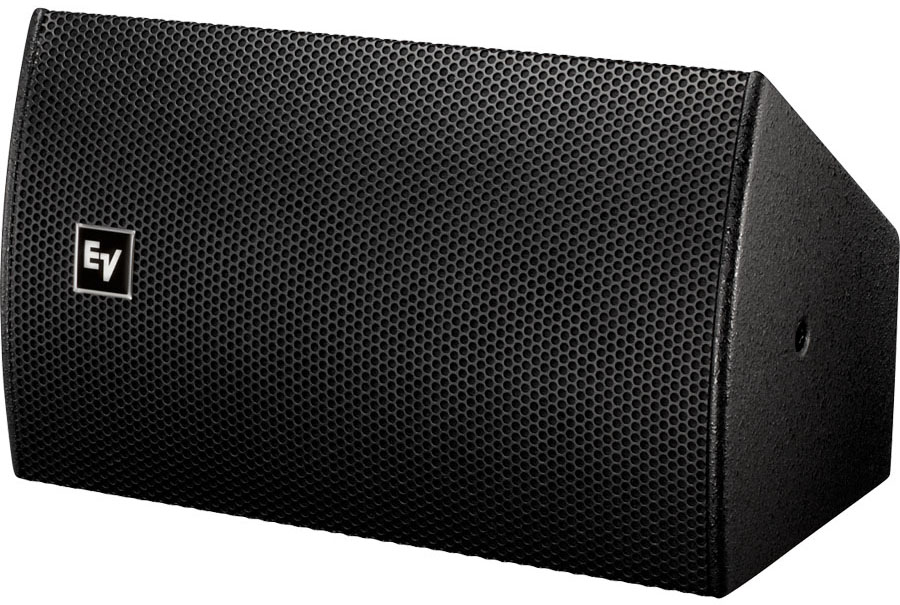 In order to meet the demand of the installed sound systems market, Electro-Voice offers a series of specific products under the name “EV-Innovation”. Within this series, four different formats can fulfil almost all the needs of consultants, installers and system integrators.
In order to meet the demand of the installed sound systems market, Electro-Voice offers a series of specific products under the name “EV-Innovation”. Within this series, four different formats can fulfil almost all the needs of consultants, installers and system integrators.
The speaker we tested is part of the EVU line, where U stands for ‘Ultracompact’, and it is designed specifically to respond to the problem of supplemental sound reinforcement.
Design
EVU-1082 is an enclosure designed to be used as a fill speaker, wherever you need sound reinforcement to fill in the gaps in the main sound system’s coverage. The trapezoidal shape and the asymmetric profile of the cabinet are meant to minimize the protrusion from the wall, the bottom of a balcony or the edge of the stage that needs to host it.
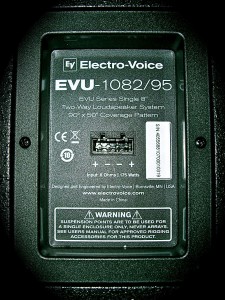
The model name 1082/95 indicates that it is a two-way system, with a single 8” HP woofer (1082) and a 90° x 50° waveguide (/95) – there are also 1062 and 2062 models, a two-way with dual 6” woofers and a two-way with dual 8” woofers, respectively. All of these feature the same tweeter (1,3” diaphragm) coupled with a rotating, constant-directivity horn.
In order to ease installation, the provided universal support allows you to position the speaker horizontally and to aim it precisely in elevation and azimuth. The enclosure can also be positioned vertically. For this purpose, four integrated metal M8 threaded points on the front can be coupled with an OMNIMOUNT™ support. The 9-ply, hardwood plywood cabinet is finished with a textured paint giving a water-drop effect. The transducers are concealed by an acoustically transparent cloth behind a nice, perforated grille. More than anything, design-wise this little enclosure aims at going unnoticed, so much that, to fit in with the surrounding environment, it can be customized either with an anthracite black or an ivory finish.
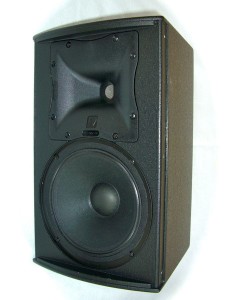
By the lack of handles or pole-mounting flange, but also by the presence of the very specific Euroblock connector, we know we are dealing here with an installation enclosure, no doubt about it. Though minimalist, the connection panel informs us of the essential features. In particular, it is a two-way model with 175 W power handling and 8 ohm impedance, the dispersion angles are 90° x 50° and the M8 inserts should never be used to suspend more than one unit at a time.
As the law requires, it also notifies that, though Electro-Voice conceived and designed the project in the land of Uncle Sam, the manufacture was carried out in the middle Kingdom, in other words, the People’s Republic of China.
Finally, to facilitate a 70 V or 100 V constant voltage distribution line, an optional EVU-TK60 transformer can be fitted to the back of the box in place of the existing panel.
Once the grille is removed, the front reveals the constant directivity horn and the little eight-inch woofer mounted in direct radiation. No bass reflex loading for the latter transducer, whose primary purpose is not low-end efficiency.
The transducers
LF
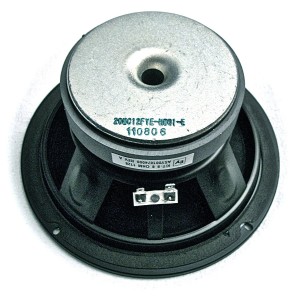
The ICT-8 woofer was designed with the help of FEA (Finite Element Analysis) modeling software to refine its dynamic behavior. According to Electro-Voice, this method optimizes both sensitivity and intelligibility in the spectral band of the voice. This did not, however, hamper the creation of a classic design. Let’s take a look: a ferrite magnet with a centralized ventilation shaft, a rigid paper cone, a stamped metal basket, and a spider suspension device in half roll of coated fabric… technological solutions that mostly date from the very genesis of the electrodynamic loudspeaker. Yet this little massive and powerful woofer, despite its old technology, displays good performance from a modern standpoint, especially with a maximum half-space SPL of about 123 dB.
HF
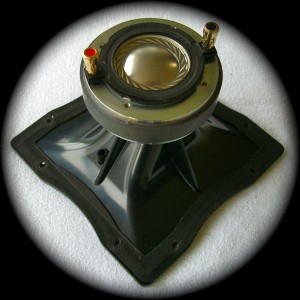
The small high-frequency driver also uses a relatively large ferrite magnet. Its 35 mm titanium diaphragm is coupled with a one inch throat. The concentric rings of the phase plug open into the horn. While at the front of the motor assembly, a fine wire mesh prevents dust from entering the horn and travelling back towards the air gap. At the rear, a thick acoustic foam inserted in the front casing is responsible for damping the resonant modes of the membrane. Finally, the 90 ° x 50 ° constant directivity horn can be adapted to the topology of the audience and the orientation of the enclosure by simply rotating it 90°.
Filtering
The relatively sophisticated electronics use two separate printed circuits.
One serves the woofer and provides a simple 3rd order low-pass filter. The other, more important, is for the tweeter and implements the 3 rd order high-pass filter, the equalization circuit charged to linearize the frequency response in the vocal range and finally, a limiting system to protect against thermal overload.
The crossover frequency of the filter network is set at 2.3 kHz.
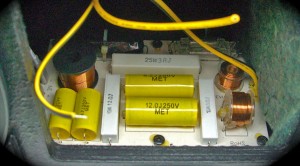
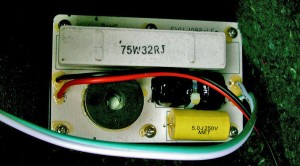
Measurements
Impedance
The impedance curve is typical of a sealed, two-way enclosure. The peak at 100 Hz is the resonance of the woofer in the enclosed volume of the EVU-1082/95. The minimum impedance occurs around 250 Hz and corresponds to the nominal impedance of the speaker. This minimum is 8 ohms and fully conforms to the indications on the rear panel. At around 3.5 kHz, a second resonance peak appears but it is less pronounced. This is the tweeter’s one. The undulations between 1500 Hz and 2500 Hz represent the overlap zone of the filter network.

Phase and amplitude
The full-axis phase response reveals a delay of 90° of the treble relative to the bass. This value, which represents a quarter wavelength at the crossover frequency, is quite small and disappears when the measurement is performed on the horn axis.
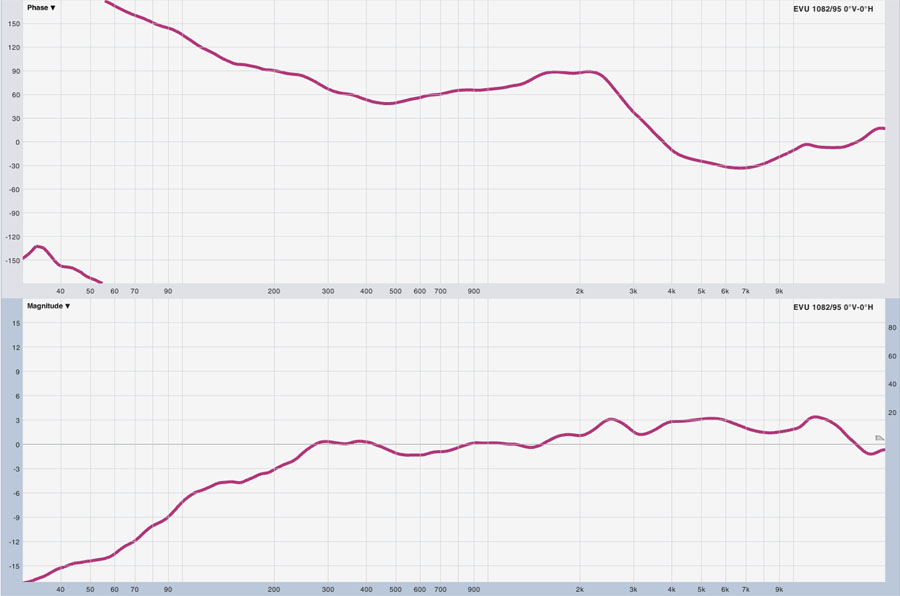
The amplitude response is remarkable, remaining within 0/+3 dB from 250 Hz to 20 kHz. Below this band, the curve drops steadily with an average slope of 6 dB/octave down to 30 Hz This response is nearly ideal for a fill speaker whose main objective is to restore intelligibility in areas with poor coverage by the main PA.
Off-axis responses
For these measurements, the horn was positioned to provide a dispersion of 50° in the horizontal plane and 90° in the vertical plane.
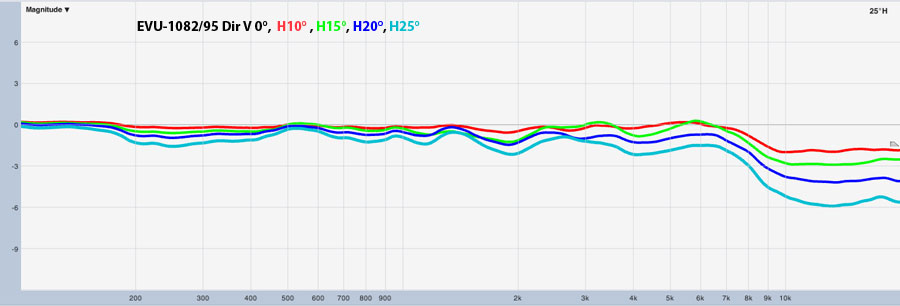
Measured in the horizontal plane and in the coverage area of the horn, the 50° coverage is verified and the tonal balance is homogeneous up to 8 kHz.
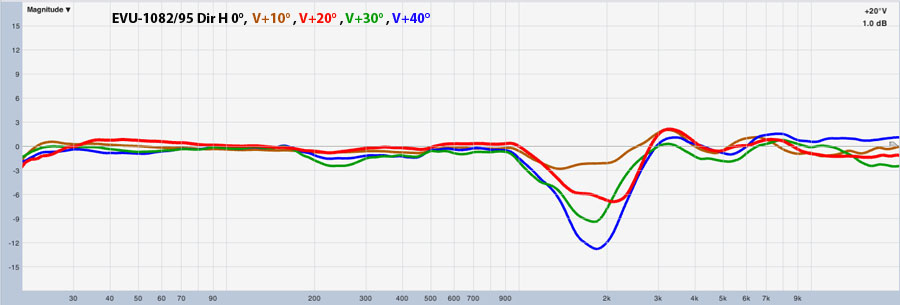
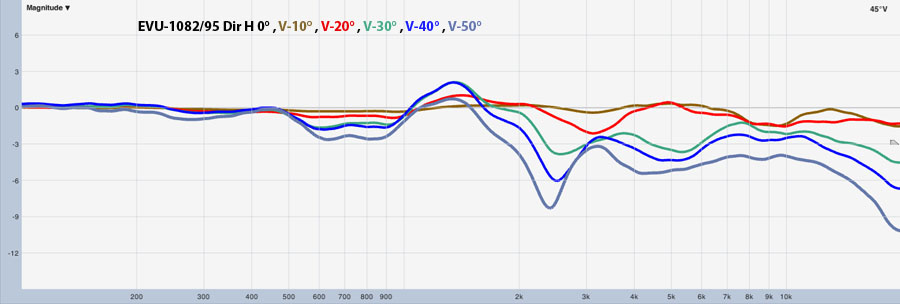
In the vertical plane, away from the axis of the enclosure, the horn does a remarkable job within 90°, but the difference in the acoustic paths between tweeter and woofer induces significant interference in the octave band centered around 2 kHz.
Listening
Listening on the axis of the small EVU1082/95, the spoken voice is quite convincing. This speaker sounds clear and without noticeable distortion. Intelligibility is good, surely made easier first by the presence of small boost of the horn in the upper midrange and, second, by the lack of bass presence in the lowest decade of the audio bandwidth.
Listening up to 25° off-axis in the horizontal plane, the response is properly preserved. In the vertical plane, however, the midrange becomes compromised and quickly loses its fullness.
Conclusion
The EVU 1082/95 meets the specifications of a very specialized rienforcement speaker. It is not intended to replace the main system. Its power, scope and its bandwidth in the bass are therefore restricted.
But in the application where it excels – the installed fill enclosure – this small speaker with its discreet aesthetic is quite appropriate and should appeal to specialized integrators.
Characteristics of the manufacturer
| Freq. Response1 (-3 dB): | 110 Hz – 16 kHz |
| Freq. Range1 (-10 dB): | 65 Hz – 20 kHz |
| Rotatable Coverage: | 90° x 50° |
| Rec. High-Pass Frequency: | 90 Hz |
| Passive Crossover Freq.: | 2300 Hz |
| Axial Sensitivity1: | 95 dB (1 W/1 m) |
| Max. Calculated SPL1: | 123 dB |
| Passive Power Handling2: | 175 W continuous, 700 W peak |
| Impedance: | 8 ohms (nominal), 6.0 Ω (min.) |
| LF Transducer: | ICT-8-8, 8” (203mm) driver |
| HF Transducer: | ICT-1-8, 1.3” (33mm) diaphragm compression driver |
| Connectors: | Single four-pin 12 AWG Phoenix/Euro Block screw-terminals |
| Enclosure: | 9-ply hardwood plywood with textured paint |
| Grille: | 18 GA steel with cloth |
| Environmental: | IEC 60529 |
| Suspension: | (6) M8 threaded suspension points |
| Dimensions (H x W x D): | 9.73” x 16.11” x 9.34” (247.2 mm x 409.1 mm x 237.2 mm) |
| Net Weight: | 16.3 lb (7.4 kg) |
| Shipping Weight: | 22.6 lb (10.2 kg) |







